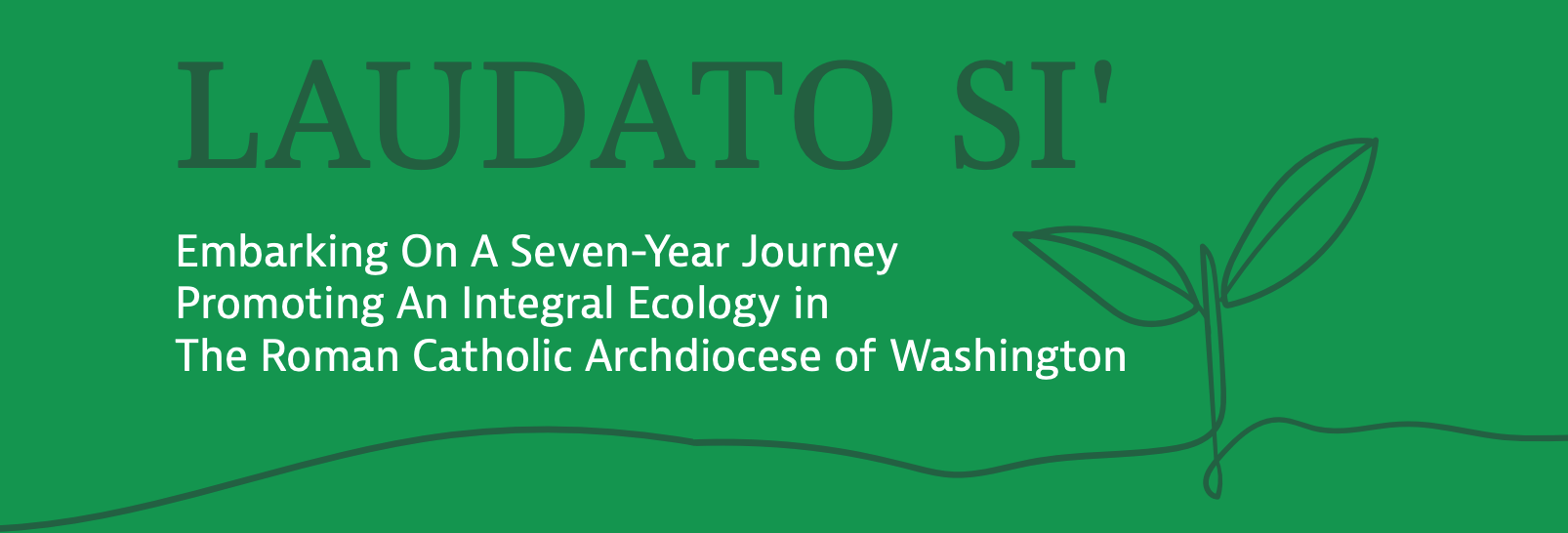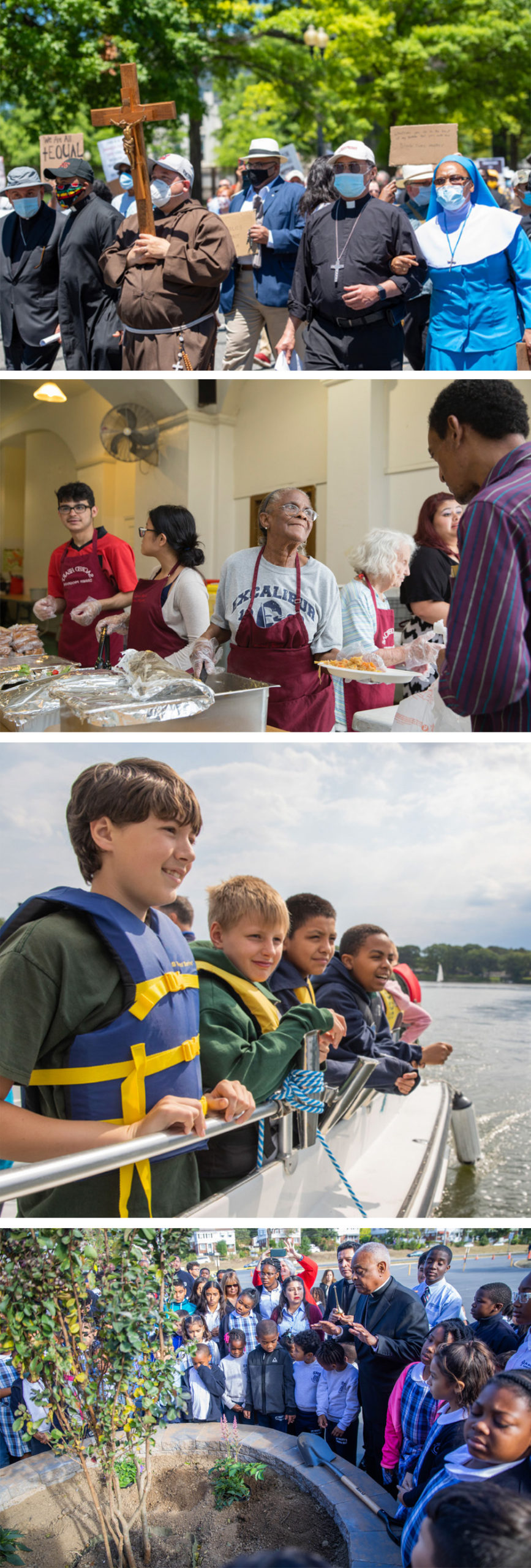Laudato Si’ Action Plan

In the years since Laudato Si’ was released, many dioceses, parishes, parish schools, religious communities and families have embraced the call of integral ecology so that the earth is protected for future generations. However, there is still much work to be done to protect our common home, the earth!
To mark the 5th anniversary of Laudato Si’, Cardinal Gregory celebrated a special Mass where he announced that the archdiocese will issue an archdiocesan Laudato Si’ Action Plan. For the 5th anniversary of Laudato Si’, the Holy See’s Dicastery (Office) for Promoting Integral Human Development published a document that names seven ways to implement Laudato Si’. The Dicastery’s document serves as the framework for the Roman Catholic Archdiocese of Washington’s Laudato Si’ Action Plan. Through this plan, we embrace the call of Pope Francis in Laudato Si’ to work toward an integral ecology that is reflected in our personal lives and in our parishes and parish schools.
An Invitation from Cardinal Gregory
Watch this video message from Cardinal Gregory, who invites us all to join in exercising stewardship over God’s creation!
 Laudato Si’ Week is an eight-day campaign held annually in May to mark the anniversary of Pope Francis’ landmark encyclical on creation care. Find prayer and action resources to engage your community.
Laudato Si’ Week is an eight-day campaign held annually in May to mark the anniversary of Pope Francis’ landmark encyclical on creation care. Find prayer and action resources to engage your community.

“This Action Plan is for all of us! We are all called to protect our common home according to our ability and means. This Action Plan contains small and big ways for us to exercise stewardship over God’s creation. I invite each of you to study this Action Plan and be challenged to protect and restore our fragile Earth and our natural resources.”
Click here to read the full text of Cardinal Wilton D. Gregory’s opening letter to the Laudato Si’ Action Plan.
Seven markers for measuring the implementation of Laudato Si’

To help individuals and communities become more sustainable, the Holy See’s Dicastery for Promoting Integral Human Development names seven markers that help to measure the implementation of Laudato Si’. These markers are used in our Action Plan as a way to promote integral ecology in Laudato Si’s implementation here in our own archdiocese.
- Response to the Cry of the Earth: greater use of clean renewable energy and reduction of fossil fuels in order to achieve carbon neutrality efforts to protect and promote biodiversity guaranteeing access to clean water for all, etc.
- Response to the Cry of the Poor: defense of human life from conception to death and all forms of life on Earth, with special attention to vulnerable groups such as indigenous communities, migrant children at risk through slavery, etc.
- Ecological Economics: sustainable production, Fair Trade, ethical consumption, ethical investments, divestment from fossil fuels and any economic activity harmful to the planet and the people, investment in renewable energy, etc.
- Adoption of Simple Lifestyle: sobriety [intense focus] in the use of resources and energy, avoid single-use plastic, adopt a more plant-based diet and reduce meat consumption, greater use of public transport and avoid polluting modes of transportation, etc.
- Ecological Education: re-think and re-design educational curricula and educational institution reform in the spirit of integral ecology to create ecological awareness and action, promoting the ecological vocation of young people, teachers and leaders of education, etc.
- Ecological Spirituality: recover a religious vision of God’s creation, encourage greater contact with the natural world in a spirit of wonder, praise, joy, and gratitude, promote creation- centered liturgical celebrations, develop catechesis prayer, retreats, formation, etc.
- Emphasis on Community Involvement and Participatory Action: to care for creation at the local, regional, national and international levels (promote advocacy and people’s campaigns, encourage rootedness in local territory and neighborhood ecosystems, etc.)
The Laudato Si’ Action Plan focuses on how the Dicastery’s seven markers, identified above, can be implemented in the archdiocese through our archdiocesan offices, parishes, parish schools and our families. Each section of the Action Plan is divided by a marker and contains several options that parishes, parish schools, families and others can begin to implement in order to become better stewards of God’s creation, help reverse climate change, and work towards sustainability as proclaimed in Laudato Si’.
Getting started at your parish
Parishes and parish schools can support the goals and vision laid out in Laudato Si’ by forming a Green Team, which is a group of parishioners of all ages who wish to ensure their parish and parish school are embracing the call to Care for God’s Creation. The name Green Team comes from the idea of shared values of protecting all of God’s creation, the earth and humanity. Forming a team is an important step in responding to Pope Francis’ call to an integral ecology.
Several ADW parishes have established Green Teams already. Contact Deborah McDonald at [email protected] to connect with other teams throughout the Roman Catholic Archdiocese of Washington.
How to form a Green Team
- Recruit parishioners: Work with your pastor, principal, and staff to recruit interested parishioners. Be sure to include people of all ages – children, youth, young adults, adults and retirees.
- Learn together: Begin reading Laudato Si’ and discuss it together as a team. Read The Roman Catholic Archdiocese of Washington’s Laudato Si’ Action Plan, and discuss possible implications for the parish and parish school.
- Make a plan: Based on your Action Plan discussions, set priorities, create goals and action steps, and determine ways to engage parish families and the larger community.
- Communicate: Share your plan with the community – your parish and parish school. Talk about actions your parish is taking in your parish Flocknote emails, in the bulletin, and on parish social media accounts. Invite the parish to participate in events and work projects.
- Ongoing parish formation: Explore and implement resources to support ongoing parish formation. Utilize age-appropriate curriculum in your religious education programs and in your parish school.
Catechetical and Liturgical Resources
Laudato Si’ Discussion Guide from the USCCB: This guide includes materials for prayer, reflection and discussion, as well as ideas to help Catholics respond to Pope Francis’ call in Laudato Si’.
Resources for liturgy, preaching and taking action from the USCCB: This guide includes liturgical aids; scripture, prayer and music resources; materials for preaching; and helpful quotes. The USCCB has also compiled a document containing pastoral aids and homily prompts for Catholic social teaching, which can be viewed here.
Prayers: This Common Prayer for Earth and Humanity was shared by Pope Francis on the fifth anniversary of Laudato Si’. The USCCB has published a Prayer to Care for Our Common Home. The Franciscan Mission Service has shared a beautiful Ecological Stations of the Cross.
Laudato Si’ Action Platform: The Dicastery for Promoting Integral Human Development’s Laudato Si’ Action Platform is a space for institutions, communities, and families to learn and grow together.
Symposium on Social Concerns
Learn more about the work of the Office of Social Concerns through this recording of a virtual symposium held in May 2020. Participants included Cardinal Gregory, Care for Creation Committee chair Dr. Bob Simon, and Bread for the World Catholic Latino representative Ms. Dulce Gamboa.
Curriculum Guides for Schools and Religious Education Classes
Laudato Si’ Indicators from the Forming Disciples for the New Evangelization Curriculum Guide
Questions? For more information contact the Office of Social Concerns.
